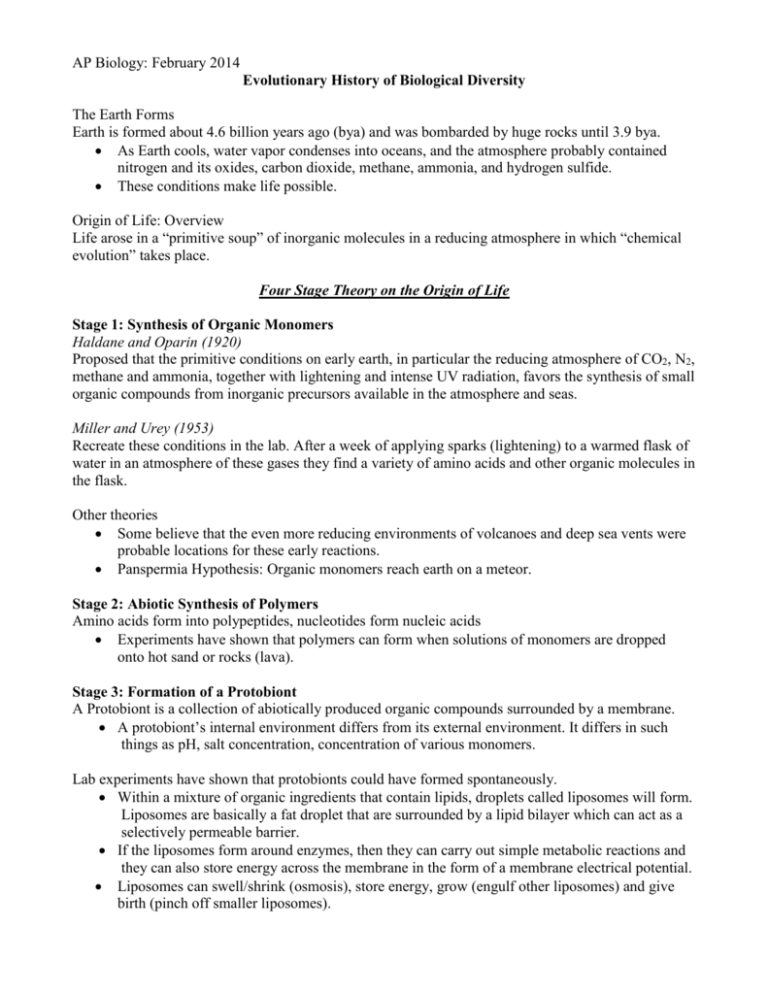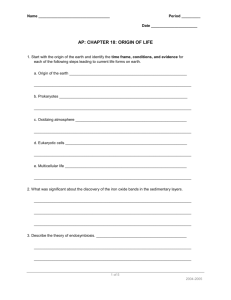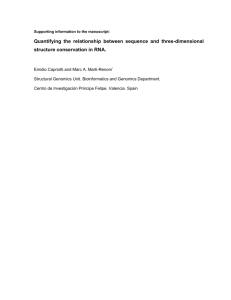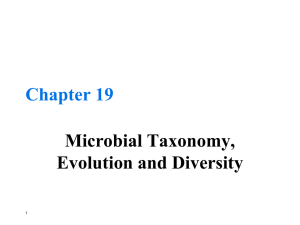Evol Hist AO 2014
advertisement

AP Biology: February 2014 Evolutionary History of Biological Diversity The Earth Forms Earth is formed about 4.6 billion years ago (bya) and was bombarded by huge rocks until 3.9 bya. As Earth cools, water vapor condenses into oceans, and the atmosphere probably contained nitrogen and its oxides, carbon dioxide, methane, ammonia, and hydrogen sulfide. These conditions make life possible. Origin of Life: Overview Life arose in a “primitive soup” of inorganic molecules in a reducing atmosphere in which “chemical evolution” takes place. Four Stage Theory on the Origin of Life Stage 1: Synthesis of Organic Monomers Haldane and Oparin (1920) Proposed that the primitive conditions on early earth, in particular the reducing atmosphere of CO2, N2, methane and ammonia, together with lightening and intense UV radiation, favors the synthesis of small organic compounds from inorganic precursors available in the atmosphere and seas. Miller and Urey (1953) Recreate these conditions in the lab. After a week of applying sparks (lightening) to a warmed flask of water in an atmosphere of these gases they find a variety of amino acids and other organic molecules in the flask. Other theories Some believe that the even more reducing environments of volcanoes and deep sea vents were probable locations for these early reactions. Panspermia Hypothesis: Organic monomers reach earth on a meteor. Stage 2: Abiotic Synthesis of Polymers Amino acids form into polypeptides, nucleotides form nucleic acids Experiments have shown that polymers can form when solutions of monomers are dropped onto hot sand or rocks (lava). Stage 3: Formation of a Protobiont A Protobiont is a collection of abiotically produced organic compounds surrounded by a membrane. A protobiont’s internal environment differs from its external environment. It differs in such things as pH, salt concentration, concentration of various monomers. Lab experiments have shown that protobionts could have formed spontaneously. Within a mixture of organic ingredients that contain lipids, droplets called liposomes will form. Liposomes are basically a fat droplet that are surrounded by a lipid bilayer which can act as a selectively permeable barrier. If the liposomes form around enzymes, then they can carry out simple metabolic reactions and they can also store energy across the membrane in the form of a membrane electrical potential. Liposomes can swell/shrink (osmosis), store energy, grow (engulf other liposomes) and give birth (pinch off smaller liposomes). Stage 4: Self-Replicating Polymers get Trapped Inside a Protobiont: The “RNA World” Emerges (i) It is hypothesized that Protobionts form on early earth and they form around RNA, polypeptides and organic monomer molecules. Polypeptides (proteins) get incorporated into the lipid bilayer making it selectively permeable. RNA is the first molecule of replication. Why RNA and not DNA? a. RNA has a central role in protein synthesis (mRNA, rRNA, tRNA) b. RNA can act as a catalyst (assist synthesis of new RNA) c. RNA can assume a variety of shapes (see tRNA’s) Therefore: RNA has both a GENOTYPE (sequence of nucleotides) and PHENOTYPE (shape), both of which show variation. (ii) RNA variants replicate: Some RNA variants are better at replicating than others perhaps due to the conditions inside the protobiont. The protobiont’s internal environment “selects for” specific RNA variants. This is a primitive form of natural selection. The selected RNA variants replicate and mutations occur which result in more RNA variants for selection to work on. (iii) RNA- Directed Protein Synthesis Occurs Amino acids bind to new RNA variants (create tRNA’s) Short polypeptides form which act as enzymes and get embedded in the membrane to increase membrane selectivity. End Result: A Protobiont or “First Living Cell” that: Has self-replicating RNA which also has catalytic properties. Has the ability to grow, split and pass on some of their RNA to daughter protobionts. Can be acted upon by natural selection. The differential success of these protobiont offspring would have accumulated metabolic and hereditary improvements. Eventually, DNA, a more stable genetic molecule, replaces RNA as the carrier of genetic information. Evolution of Eukaryotes: Serial Endosymbiosis The theory of serial Endosymbiosis explains the evolution of eukaryotic cells from a prokaryotic ancestor. Ancestral protobionts evolve into various prokaryotic cells. A smaller prokaryotic cell is engulfed by a larger prokaryotic cell. Each cell gained a benefit from the association; perhaps the smaller one was protected from the environment and the larger one gained some nutrient support. Over time, the two would become one cell; the smaller one becoming a mitochondrion if it was heterotrophic or a chloroplast if it was autotrophic. Evidence: Both mitochondria have their own DNA and ribosomes. The membranes of mitochondria and chloroplasts are more like the membrane of a prokaryote. The Fossil Record: Chronicles Life on Earth The geological record is divided into 3 eons: The Archaean and Proterozoic eons lasted approx 4 billion years and are collectively referred to as the “Precambrian”. The Phanerozoic eon covers the last half billion years and is divided into 3 eras: The Paleozoic, Mesozoic and Cenozoic eras. These eras are delineated by major transitions such as mass extinctions and extensive adaptive radiations. Extinction events are important because they open up ecological niches for the survivors. Major Extinctions of Note 1. Permian Extinction (250 million years ago). The cause is massive volcanic activity around Siberia. Causes global warming which leads to decreased ocean mixing which in turn depletes the O2 supply to marine life. 96% of all marine animal species and many land species become extinct. 2. Cretaceous Extinction (65 million years ago) Asteroid/comet hits earth along the Yucatan Peninsula causing a massive dust cloud that blocks out the sun for a few years. Plant life (not seeds) is gone in 3 months. Dinosaurs become extinct, as well as 50% of marine species and many land species. Chronology of Life on Earth 1. Prokaryotes evolve and change the early earth. (3.5 → 2 billion years ago) The first autotrophs evolve from protobionts, they produce their own needed compounds and some diverge and begin to harness light energy. Heterotrophs emerge that live off the products of autotrophs or feed on the autotrophs themselves. Autotrophic and heterotrophic prokaryotes diverge to become bacteria and archaea species and were the sole inhabitants of Earth from 3.5 to about 2 billion years ago. Key Evolutionary Events in this period: 1. Chemiosmotic production of ATP (electron transport chain) evolves: this is common to all 3 domains so it must have evolved early. How? Membrane proton pumps that used ATP to expel hydrogen ions to regulate pH were probably co-opted to produce more ATP. 2. Non-Oxygenic Photosynthesis evolves Some prokaryotes are able to split H2S (hydrogen sulfide) to supply electrons; however there is no oxygen produced as a byproduct). 3. Oxygenic Photosynthesis evolves in cyanobacteria. Cyanobacteria (also called blue-green algae) are the only living (presently) photosynthetic bacteria that can generate oxygen. This occurs as early as 3.5 bya. Evidence: See rusting of iron in terrestrial rocks at 2.7 bya, evidence of O2 production. Free oxygen starts to dissolve in the seas and lakes and they become saturated with oxygen. 2. Oxygen builds up in the Atmosphere (2.7 – 2.1 billion years ago) Around 2.7 bya, oxygen starts building up in the atmosphere and this build up increases dramatically around 2.2 bya. This increase in atmospheric O2 causes the extinction of many prokaryotic groups (oxygen is poisonous to them) and relegates others to anaerobic habitats. Why? Oxygen attacks chemical bonds, inhibits enzymes and damages prokaryotic cells. The Prokaryotes that survived: Had the ability to convert O2 to something less damaging or were less sensitive to O2 or they adapted electron transport mechanisms to aerobic respiration which then produced more ATP than anaerobic respiration. Basically, the increase in atmospheric O2 created a new ecosystem to be exploited. 3. Eukaryotic Life Begins: (earliest eukaryotic fossils are seen about 2.1 billion years ago) Endosymbiosis The first eukaryotes may have been predatory prokaryote that engulfed an smaller, aerobic heterotrophic prokaryote and packaged it inside a vacuole. The smaller prokaryote becomes an endosymbiont, living within the host cell. Eventually, the relationship becomes mutualistic and the endosymbiont evolves into a mitochondrion. Chloroplasts, which started out as photosynthetic prokaryotes (cyanobacteria) may have evolved through a similar endosymbiotic process. In this Serial Endosymbiosis, mitochondria probably arose first b/c they are present in all eukaryotes. Overtime, further endosymbiotic events occurred and genes are transferred from the mitochondria or chloroplast to the nucleus of the host cell. Evidence for Endosymbiosis 1. Both mitochondria and chloroplasts have there own phospholipid bilayer. The inner membrane of each organelle has similar structure and function (see chemiosmosis/ATP production). 2. Both have their own circular DNA and replicate via binary fission. 3. Comparisons of small subunit rRNA indicates that alpha proteobacteria are the closest relatives of mitochondria and that cyanobacteria are the closest relatives of chloroplasts. Other Speculations The nucleus of eukaryotes evolved from an archaeal endosymbiont—genes with close relatives in bacteria and archaea have been found in eukaryotic nuclei. Eukaryotes occasionally incorporated some of the genes of their bacterial and archaeal prey into their nucleus. “you are what you eat” so to speak. The golgi apparatus and ER originated from infoldings in the plasma membrane. 4. Multicellular Eukaryotes Arose: 1.2 billion years ago Unicellular eukaryotes exist as colonies of independent replicating cells. Some cells of the colony become specialized, that is they perform a specific function. Multicellularity evolves several times among early eukaryotes. The ice-age at the time restricts their size and diversity: This is the “Snowball Earth” hypothesis. 5. The Cambrian Explosion Around 500 million years ago the ice age ends and you get the Cambrian explosion which is defined by large scale diversification. First animals to evolve are porifera (corals) and cnidarians (jellyfish, hydra). The appearance of most major phyla of animals occurs in the first 20 million years of the Cambrian period beginning about 520 mya. Colonization of Land by Plants, Fungi, and Animals about 500 mya. The move to land is accompanied by adaptations that helped prevent dehydration and allowed reproduction on land. Plants and fungi appear to have colonized the land together in symbiotic associations. Arthropods and tetrapod vertebrates are the most widespread and diverse land animals. 6. Pangaea Forms/Breaks Up Around 280 mya, large continental drift brings all land masses together to form Pangaea, one massive supercontinent. This has great environmental impact as: Shorelines are eliminated Shallow coastal areas are drained Most land becomes part of the continental interior Many species become extinct and new opportunities arise for the survivors. Around 180 mya, Pangaea breaks apart and the continents drift creating a huge geographic isolation event.






